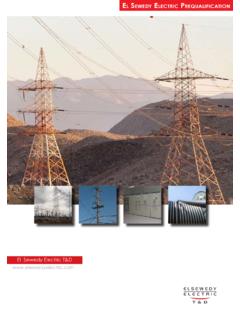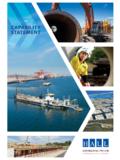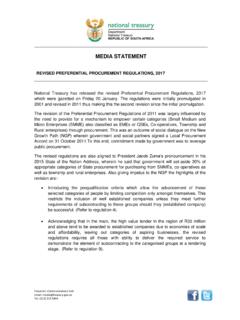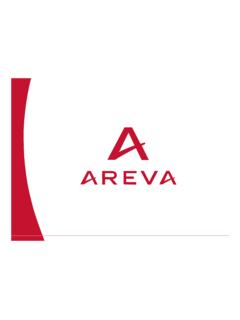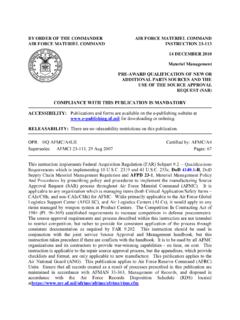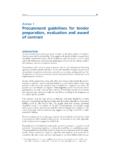Transcription of Collaborative procedure between the World Health ...
1 Collaborative procedure between the World Health organization Prequalification of Medicines Programme (WHO/PQP) and national medicines regulatory authorities (NMRAs) in the assessment and accelerated national registration of WHO prequalified pharmaceutical products and vaccines Revision 1, draft for comments 1. Definitions 2. Background information 3. Principles of collaboration 4. Steps in the collaboration for national registration of a pharmaceutical product or a vaccine 5. Collaboration mechanisms for post-prequalification and/or post- registration variations 6. Withdrawals, suspensions or delistings of prequalified pharmaceutical products or vaccines and national deregistrations Appendix 1: NMRA participation agreement and undertaking for NMRA focal point(s).
2 Appendix 2: Consent of WHO prequalification holder for WHO to share information with NMRA. confidentially under the procedure Appendix 3: Expression of interest to NMRA for the assessment and accelerated national registration, acceptance by NMRA and notification of procedure outcomes Appendix 4: Report on post-registration actions in respect of a product registered under the procedure 1. 1. Definitions Collaborative procedure ( procedure ). procedure for collaboration between the WHO Prequalification Programme (WHO/PQP) and interested national medicines regulatory authorities(NMRAs) in the assessment and accelerated national registration of WHO prequalified pharmaceutical products and vaccines. Participating authorities or participating NMRAs NMRAs that voluntarily agree to implement this Collaborative procedure and accept the task of processing applications for registration of WHO-prequalified pharmaceutical products and vaccines in accordance with the terms of the procedure .
3 A list of participating authorities is posted on the WHO/PQP. web site ( ). Pharmaceutical product Any substance or combination of substances marketed or manufactured to be marketed for treating or preventing disease in human beings, or with a view to making a medical diagnosis in human beings, or to restoring, correcting or modifying physiological functions in human beings. Vaccine A vaccine is a biological preparation that improves immunity to a particular disease. A vaccine typically contains an agent that resembles a disease-causing microorganism, and is often made from weakened or killed forms of the microbe, its toxins or one of its surface proteins. The agent stimulates the body's immune system to recognize the agent as foreign, destroy it, and "remember" it, so that the immune system can more easily recognize and destroy any of these microorganisms that it later encounters.
4 2. Background information national assessment of applications for registration of pharmaceutical products and vaccines (marketing authorization) is the key regulatory process that enables NMRAs to evaluate and monitor the quality, safety and efficacy of pharmaceutical products and vaccines. For most countries the approach to registration of pharmaceutical products and vaccines is a combination of two components: the NMRA's own assessment of application documentation combined with verification of compliance with relevant good practices by inspections (mostly focusing on good manufacturing 2. practices (GMP) and inspections of manufacturing sites) and testing of product characteristics when applicable;. consideration by the NMRA of decisions and outcomes of assessments and inspections made by NMRAs in other countries.
5 Consideration of the outcomes of assessments and inspections by trusted authorities substantially contributes to savings in regulatory resources and improvements in the quality of regulatory decisions, while retaining the prerogative of NMRAs to conclude their assessment by sovereign decisions, which reflect their own judgement of the benefit risk balance as it relates to their specific country situation and the legislation in place. Taking into consideration the regulatory decisions of other NMRAs requires setting up a system that will permit: identification of reference authorities whose regulatory decisions are based on acceptable standards and identification of documents associated with such regulatory decisions, which are relevant to the regulatory environment in the country wishing to rely on such decisions.
6 Assurance that the product for which the decision has been taken by the reference NMRA is identical to the product being assessed, or, if it is not identical, that a clear understanding exists of the differences between the products subjected to assessment in the two regulatory environments;. efficient use of available scientific expertise and human and financial resources to decide, with reasonable certainty, on the benefit risk profile of an evaluated product when used in a given country;. the choice by each NMRA of the approaches that will make best use of the resources, workload and competence of individual NMRAs. Approaches could range from completely independent data reviews and inspections to adoption of regulatory decisions of trusted authorities without any further scientific review.
7 A pragmatic approach is to verify product identity and assess only those areas which relate to use of the product in the country concerned and where failure to comply with regulatory standards could pose Health risks. In the other areas, the outcomes of trusted authorities may be adopted. This procedure is based on the above-mentioned considerations. In line with the procedure for prequalification of pharmaceutical products1, and the procedure for assessing the acceptability in 1. procedure for prequalification of pharmaceutical products. In: WHO Expert Committee on Specifications for Pharmaceutical Preparations. Forty-fifth report. Geneva, World Health organization , 2011 (WHO Technical Report Series, No. 961), Annex 10. 3.
8 Principle of vaccines for purchase by United Nations Agencies2 it aims to provide a convenient tool for NMRAs wishing to enhance their pre-marketing evaluation and registration system by taking advantage of the scientific assessment work conducted by WHO/PQP. The present procedure is complementary to the WHO/PQP collaboration procedure with NMRAs in inspection activities ( , Inspections ). The Collaborative procedure has been piloted from June 2012 and is currently in use for pharmaceutical products ( , Collaborative Registration ). For vaccines, another procedure for expedited review of imported prequalified vaccines for use in national immunization programmes was published already in 2007 and has been implemented for national registrations as from 2011, however the procedure did not include Collaborative arrangements with the NMRAs.
9 Enhanced collaboration and information exchange between NMRAs and WHO/PQP benefits both partners. Subject to the agreement of the WHO prequalification holders concerned, NMRAs have access to assessment outcomes that are not in the public domain and that have been prepared in conformity with the WHO recommended standards on which the procedure for prequalification of pharmaceutical products and the procedure for assessing the acceptability in principle of vaccines for purchase by United Nations Agencies are based. Such reports and other documents help NMRAs to make their decisions and also assist in educating national regulatory staff. At the same time, feedback from NMRAs on the information and documentation received from WHO/PQP under the procedure allows WHO/PQP.
10 To improve its work and ensures that the outcomes of prequalification assessments are relevant to NMRAs. As a consequence patients and vaccinees benefit from this collaboration by gaining faster access to medicines which have been found acceptable in principle for procurement by United Nations agencies. Depending on available resources, participating authorities have the opportunity to participate in the assessment process and in inspections organized by WHO/PQP. This Collaborative procedure also benefits manufacturers of prequalified pharmaceutical products and vaccines through faster and better harmonized regulatory approvals in participating countries. This procedure , when combined with the Collaboration procedure with NMRAs in inspection activities, alleviates the burden of additional national inspections on manufacturers.










